Munish Sharma completed an 8-week summer internship at LG Electronics India Limited in their Research and Development division for washing machines. The internship involved working on the development of a new 21-inch washing machine for export to Indonesia, including concept development, feasibility analysis, and data collection on competitor features. Munish also conducted testing of new washing machines in the reliability center, diagnosing any issues found and suggesting solutions to implement. The internship provided valuable experience in product development and quality assurance.
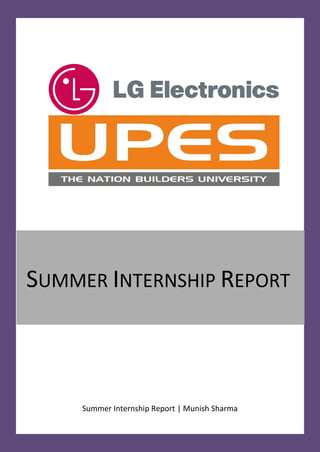

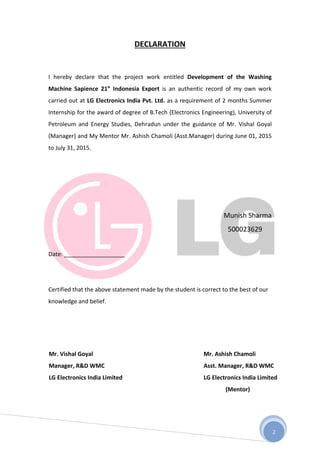


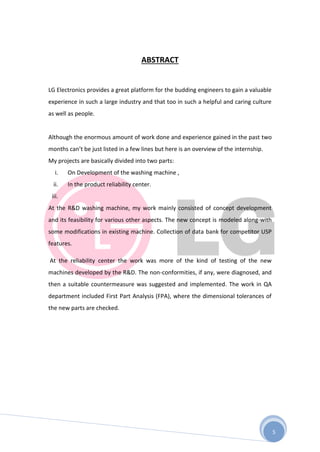
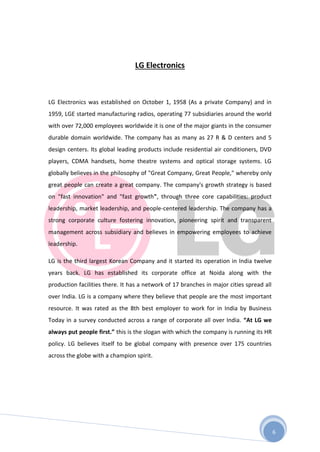











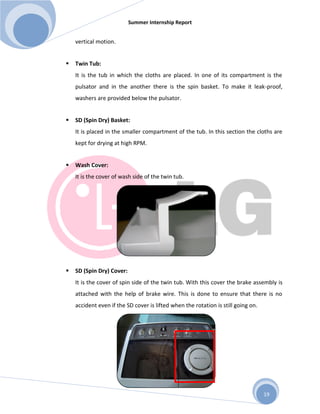


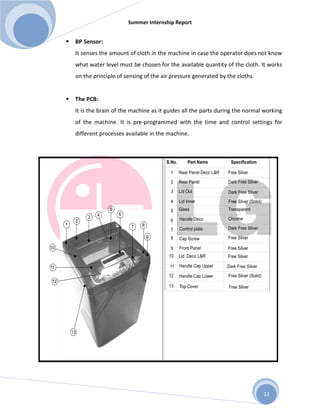














![Summer Internship Report
37
OPERATION
An opto-isolator contains a source (emitter) of light, almost always a near infrared light-
emitting diode (LED), that converts electrical input signal into light, a closed optical channel
(also called di-electrical channel[7]
), and a photo-sensor, which detects incoming light and
either generates electric energy directly, or modulates electric current flowing from an
external power supply. The sensor can be a photo-resistor, a photodiode, a phototransistor,
a silicon-controlled rectifier (SCR) or a TRIAC. Because LEDs can sense light in addition to
emitting it, construction of symmetrical, bidirectional opto-isolators is possible. An opto-
coupled solid state relay contains a photodiode opto-isolator which drives a power switch,
usually a complementary pair of MOSFETs. A slotted optical switch contains a source of light
and a sensor, but its optical channel is open, allowing modulation of light by external
objects obstructing the path of light or reflecting light into the sensor.
BACK EMF
The counter-electromotive force also known as back electromotive force or counter EMF is
the voltage, or electromotive force, that pushes against the current which induces it. CEMF
is caused by a changing electromagnetic field. It is the effect of Lenz's Law of
electromagnetism. Back electromotive force is a voltage that occurs in electric motors
where there is relative motion between the armature of the motor and the external
magnetic field. One practical application is to use this phenomenon to indirectly measure
motor speed and position. Counter EMF is a voltage developed in an inductor network by a
pulsating current or an alternating current. The voltage's polarity is at every moment the
reverse of the input voltage
In a motor using a rotating armature and, in the presence of a magnetic flux, the conductors cut the
magnetic field lines as they rotate. The changing field strength produces a voltage in the coil; the
motor is acting like a generator. This voltage opposes the original applied voltage; therefore, it is
called "counter-electromotive force”. With a lower overall voltage across the armature, the current
flowing into the motor coils is reduced.
To experience the effect of counter-electromotive force one can perform this simple exercise. With
a window closed, lift the switch of an electric window in a car that is running at idle, and hold it
momentarily and notice the idle RPM drop. The electric motor in the door is stationary and
therefore the inrush current will be very high. The alternator will try to provide for the large current
which subsequently drags down the engine. As soon as the power window motor overcomes its
inertia and starts spinning, back EMF will be produced, exerting less load on the alternator. Hence,
the engine speed will return to normal.
In motor control and robotics, the term "Back-EMF" often refers to using the voltage
generated by a spinning motor to infer the speed of the motor's rotation.](https://image.slidesharecdn.com/267d8a13-1fbd-4a9c-803b-3ff45ff64eca-150904134108-lva1-app6891/85/Internship-Report-37-320.jpg)

![Summer Internship Report
39
automotive relays include a diode inside the relay case. Alternatively, a contact protection
network consisting of a capacitor and resistor in series (snubber circuit) may absorb the
surge. If the coil is designed to be energized with alternating current (AC), a small copper
"shading ring" can be crimped to the end of the solenoid, creating a small out-of-phase
current which increases the minimum pull on the armature during the AC cycle.[1]
A solid-state relay uses a thyristor or other solid-state switching device, activated by the
control signal, to switch the controlled load, instead of a solenoid. An optocoupler (a light-
emitting diode (LED) coupled with a photo transistor) can be used to isolate control and
controlled circuits.
EEPROM PART
EEPROM stands for Electrically Erasable Programmable Read-Only Memory and is a type of
non-volatile memory used in computers and other electronic devices to store small
amounts of data that must be saved when power is removed, e.g., calibration tables or
device configuration.
When larger amounts of static data are to be stored a specific type of EEPROM such as flash
memory is more economical than traditional EEPROM devices. EEPROMs are realized as
arrays of floating-gate transistors.
EEPROM is user-modifiable read-only memory (ROM) that can be erased and
reprogrammed repeatedly through the application of higher than normal electrical voltage
generated externally or internally in the case of modern EEPROMs. EPROM usually must be
removed from the device for erasing and programming, whereas EEPROMs can be
programmed and erased in-circuit. Originally, EEPROMs were limited to single byte
operations which made them slower, but modern EEPROMs allow multi-byte page
operations. It also has a limited life - that is, the number of times it could be reprogrammed
was limited to tens or hundreds of thousands of times. That limitation has been extended to
a million write operations in modern EEPROMs. In an EEPROM that is frequently
reprogrammed while the computer is in use, the life of the EEPROM can be an important
design consideration.](https://image.slidesharecdn.com/267d8a13-1fbd-4a9c-803b-3ff45ff64eca-150904134108-lva1-app6891/85/Internship-Report-39-320.jpg)


